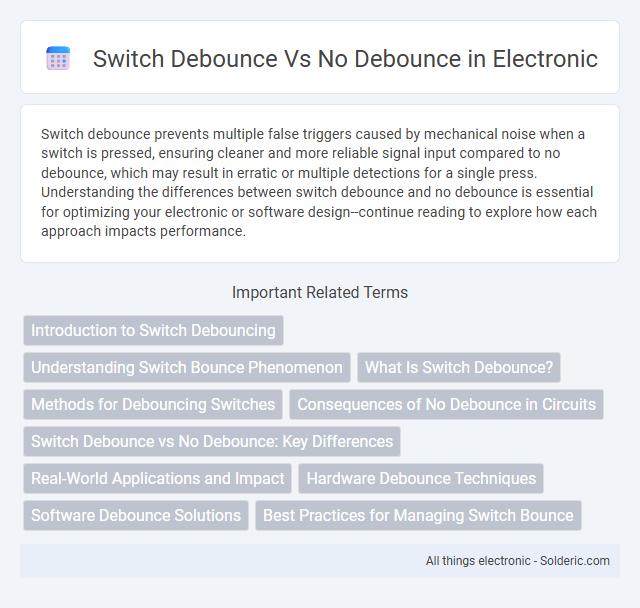Switch debounce prevents multiple false triggers caused by mechanical noise when a switch is pressed, ensuring cleaner and more reliable signal input compared to no debounce, which may result in erratic or multiple detections for a single press. Understanding the differences between switch debounce and no debounce is essential for optimizing your electronic or software design--continue reading to explore how each approach impacts performance.
Comparison Table
| Feature | With Switch Debounce | No Debounce |
|---|---|---|
| Signal Stability | Stable, clean signal output | Erratic signal with chatter |
| Accuracy | High, eliminates false triggers | Low, prone to multiple false activations |
| Response Time | Minimal delay due to debounce interval | Immediate but unreliable |
| Complexity | Requires hardware/software implementation | Simple, no extra components needed |
| Common Use Cases | Button inputs, user interfaces, precise control | Simple switches where noise is negligible |
| Power Consumption | Marginally higher if software debounce uses CPU cycles | Minimal, direct signal use |
| Cost | Potentially higher due to additional components or code | Lower, no added components |
Introduction to Switch Debouncing
Switch debouncing is a technique used to ensure a clean and stable signal output from a mechanical switch by eliminating the electrical noise caused by rapid on/off toggling when the switch contacts physically bounce. Without debounce, the microcontroller or electronic system may interpret multiple unintended transitions, leading to erratic or false inputs. Implementing debounce, either through hardware components like capacitors and resistors or software algorithms, results in accurate and reliable switch state detection essential for effective digital input handling.
Understanding Switch Bounce Phenomenon
Switch bounce occurs when mechanical contacts within a switch rapidly open and close before settling, causing multiple false signals. Without debounce techniques, microcontrollers may misinterpret these transitions, leading to erratic or repeated inputs. Implementing debounce methods, either in hardware with capacitors or software through timing algorithms, ensures clean, stable signals and accurate switch state detection.
What Is Switch Debounce?
Switch debounce is a technique used to eliminate the rapid, unintended toggling signals generated when a mechanical switch is pressed or released. Without debounce, your circuit may register multiple false triggers due to the physical bouncing of the switch contacts. Implementing debounce ensures clean, stable signals, improving the reliability and accuracy of your electronic inputs.
Methods for Debouncing Switches
Mechanical switches generate multiple rapid on/off signals when pressed, causing false triggering known as switch bounce. Methods for debouncing switches include hardware solutions such as RC (resistor-capacitor) filtering circuits, Schmitt trigger ICs, and dedicated debounce ICs, which physically smooth out signal fluctuations. Software debouncing techniques involve reading the switch state multiple times with delays or using state machines to confirm stable signals before registering input changes.
Consequences of No Debounce in Circuits
No debounce in circuits causes multiple false triggers due to mechanical switch bounce, leading to erratic and unreliable performance. This can result in unintended operations, increased wear on components, and corrupted data inputs in digital systems. Ensuring debounce mechanisms prevents signal noise, preserving the integrity of Your electronic controls and improving overall circuit stability.
Switch Debounce vs No Debounce: Key Differences
Switch debounce uses hardware or software techniques to eliminate noise caused by mechanical contacts bouncing, ensuring a clean, stable signal transition when a switch is pressed or released. Without debounce, multiple unwanted signals or rapid toggling can occur within milliseconds, leading to erratic or false triggering in electronic circuits. Implementing debounce improves reliability in digital inputs by effectively filtering transient glitches that cause multiple detections of a single switch press.
Real-World Applications and Impact
Switch debounce prevents false triggering caused by signal noise and mechanical bouncing, crucial in scenarios like industrial control systems and consumer electronics where precise input is essential. Without debounce, devices such as keyboards, microcontrollers, and home automation switches may register multiple unintended commands, leading to erratic behavior or system errors. Implementing debounce improves reliability and user experience by ensuring stable, accurate signal processing in embedded systems and automated controls.
Hardware Debounce Techniques
Hardware debounce techniques use components like capacitors, resistors, and Schmitt triggers to filter out the voltage fluctuations caused by mechanical switch contacts. These methods provide a stable signal by smoothing the rapid on-off transitions, ensuring reliable input detection in your electronic circuits. Proper hardware debouncing reduces the need for complex software algorithms, improving overall system responsiveness and reliability.
Software Debounce Solutions
Software debounce solutions improve the reliability of switch inputs by filtering out false signals caused by mechanical bouncing, ensuring stable and accurate state detection. Implementing algorithms like delay loops, state machines, or counters effectively eliminates transient fluctuations without needing additional hardware components. These methods are essential in embedded systems and microcontroller applications where minimizing hardware complexity and cost is a priority.
Best Practices for Managing Switch Bounce
Implementing debounce techniques is essential for accurate switch state detection, as mechanical switches inherently produce noise and multiple rapid on/off signals when toggled. Best practices include using hardware solutions like RC filters or Schmitt triggers, and software algorithms such as delay loops or state machines to filter out transient signals effectively. Proper debounce management improves system reliability and prevents erroneous inputs in digital circuits.
switch debounce vs no debounce Infographic

 solderic.com
solderic.com